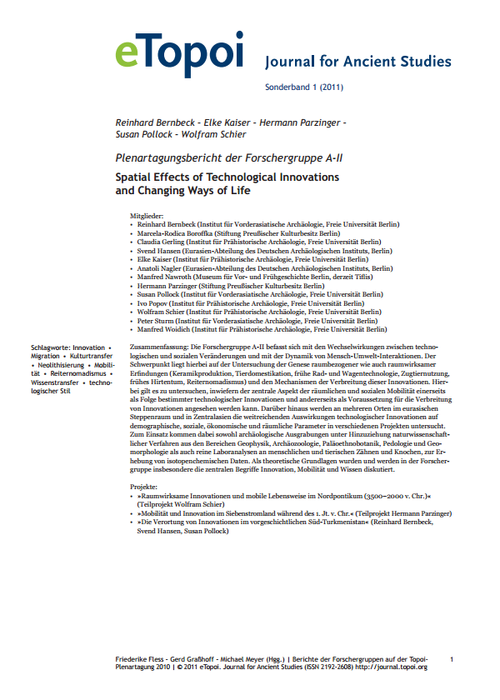Spatial Effects of Technological Innovations and Changing Ways of Life
Research Group A-II is concerned with the interdependency of technological and social change and with the dynamics of human-environment interaction. The focus is on investigations of the genesis of spatially-relevant inventions and on those having an impact on spatiality (ceramics production, domestication of animals, early wheel and carriage technologies, draft and herd animals, equestrian nomadism), and on the mechanisms through which such innovations were diffused. In this context, the aim is to determine the extent to which central aspects of spatial and social mobility may be regarded on the one hand as the consequences of specific technological innovations, and on the other as preconditions for the dissemination of innovation. Moreover, the far-reaching impact of technological innovation on demographic, societal, economic, and spatial parameters is investigated in the framework of various projects and at a number of different locations in the Eurasian steppes and in Central Asia. Deployed are both archaeological excavations with the enlistment of natural-scientific procedures from the areas of geophysics, archaeozoology, paleoethnobotany, pedology, and geomorphology, as well as pure laboratory analyses of human and animal teeth and bones for the sake of compiling isotope/chemical data. The theoretical foundations of the discussions of this research group have been and remain in particular the central concepts of innovation, mobility, and knowledge.
Die Research Group A-II befasst sich mit den Wechselwirkungen zwischen technologischen und sozialen Veränderungen und mit der Dynamik von Mensch-Umwelt-Interaktionen. Der Schwerpunkt liegt hierbei auf der Untersuchung der Genese raumbezogener wie auch raumwirksamer Erfindungen (Keramikproduktion, Tierdomestikation, frühe Rad- und Wagentechnologie, Zugtiernutzung, frühes Hirtentum, Reiternomadismus) und den Mechanismen der Verbreitung dieser Innovationen. Hierbei gilt es zu untersuchen, inwiefern der zentrale Aspekt der räumlichen und sozialen Mobilität einerseits als Folge bestimmter technologischer Innovationen und andererseits als Voraussetzung für die Verbreitung von Innovationen angesehen werden kann. Darüber hinaus werden an mehreren Orten im eurasischen Steppenraum und in Zentralasien die weitreichenden Auswirkungen technologischer Innovationen auf demographische, soziale, ökonomische und räumliche Parameter in verschiedenen Projekten untersucht. Zum Einsatz kommen dabei sowohl archäologische Ausgrabungen unter Hinzuziehung naturwissenschaftlicher Verfahren aus den Bereichen Geophysik, Archäozoologie, Paläoethnobotanik, Pedologie und Geomorphologie als auch reine Laboranalysen an menschlichen und tierischen Zähnen und Knochen, zur Erhebung von isotopenchemischen Daten. Als theoretische Grundlagen wurden und werden in der Forschergruppe insbesondere die zentralen Begriffe Innovation, Mobilität und Wissen diskutiert.

